Head Coverings and Hairstyles
Hats and other head coverings are often the hardest thing to remember and the hardest item of clothing to become accustomed to. We rarely wear hats, except for warmth in winter, and wear veils and hoods even less often. But they were essential to the medieval/renaissance wardrobe, and the way you wear your hair and cover it can make all the difference.
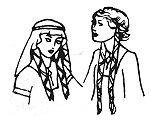
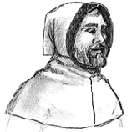
Before about the 14th century, men's hair length varied considerably, with beards also fading in and out of fashion. Close-fitting linen or wool coifs, tied under the chin, were quite common, as were hoods with short capelets that covered the shoulders. The hoods could be trimmed with fur or a contrasting fabric; the length of the point at the back of the hood varied with public whim. When it became long enough to be a separate sort of tail, it was called a liripipe.
In that same period, women's hair was invariably long. Despite the images we have, however, most women probably did not have wrist-thick braids that reached to their knees. Because the predominant head covering for a woman in this period was some sort of veil, long braid-cases (stuffed tubes of fabric bound with ribbon) could be fastened over the wearer's own braids or tied to a band worn about the head under the veil. This would give the impression of tremendously long and thick hair without actually having any. This can be very helpful for women with short modern hairstyles, who can either fashion these braid-cases, or use false hair braided or attached to their own hair (this was also another very common practice.) False hair was also used to pad out elaborate braided styles that wrapped the hair around the head or coiled it in small cages over each ear.
Throughout most of the 14th century, men's hair was worn at a medium length, sometimes curled, and faces were generally clean-shaven. In the early part of the century, they went bare-headed or wore hood and liripipe, with the liripipe getting longer and longer as hemlines grew shorter. Toward the end of the century, so as not to compete with the high collars of their clothing, men cropped their hair quite short.
 In that same period, married women covered their hair
almost entirely. (Young, unmarried women still wore their hair unbound, or loosely garlanded.) A
square of linen called a wimple was wrapped under the chin and fastened at the top of the head,
draping to form a soft frame. A veil of similar material was placed over the top of the head,
covering the fastening of the wimple. A circlet of some variety could be used to hold the veil in
place. An alternative to the wimple was a narrower band of linen called a barbette, which fit snugly
under the chin, and was also worn with a veil. Atop the barbette, some women wore a small,
pillbox-like hat, or an stiffened open oval.
In that same period, married women covered their hair
almost entirely. (Young, unmarried women still wore their hair unbound, or loosely garlanded.) A
square of linen called a wimple was wrapped under the chin and fastened at the top of the head,
draping to form a soft frame. A veil of similar material was placed over the top of the head,
covering the fastening of the wimple. A circlet of some variety could be used to hold the veil in
place. An alternative to the wimple was a narrower band of linen called a barbette, which fit snugly
under the chin, and was also worn with a veil. Atop the barbette, some women wore a small,
pillbox-like hat, or an stiffened open oval.
In keeping with the wide variance in fashions in the 15th century, men's hair was styled in many different fashions. Types of hats varied tremendously, and the only guiding principle seemed to be silliness. Fat padded hats, skinny little fezzes, wildly dagged hoods and liripipes worn sideways, fads for extravagant feathers; all were perfectly fashionable.
Women's headdresses competed with the men's in extravagance, taking on almost architectural dimensions. Cones and points abounded, often draped with sheer veiling and worn over a barbette or some other throat covering. Under these extravagant constructions, women began to pluck their hairlines farther and farther back, to produce an extraordinarily high forehead, often in conjunction with completely plucked eyebrows.
 In the early part of the sixteenth century, men began to
grow their hair longer as a general rule, and grow their beards as well. Hats tended toward the
wide and floppy, with small jeweled ornaments at the join between brim and body, sometimes securing
a feather or two. Older men also wore a close-fitting wool or felted cap, with a thick upturned brim
that could be cut to form leaves.
In the early part of the sixteenth century, men began to
grow their hair longer as a general rule, and grow their beards as well. Hats tended toward the
wide and floppy, with small jeweled ornaments at the join between brim and body, sometimes securing
a feather or two. Older men also wore a close-fitting wool or felted cap, with a thick upturned brim
that could be cut to form leaves.
Toward the end of the century, men's hats grew taller and thinner, projecting higher above the wide ruffs and narrow pointed beards that were in fashion. The brim became quite narrow, and the decoration on the band around the hat became quite pronounced. Despite the prevailing fashion for short hair, some young men who fancied themselves poetic and wild chose to wear their hair long and curled.
During the early part of the century, women's hair remained covered and hairlines stayed high, although not quite to the extreme of the previous era. Stiff hoods that came to a widow's peak in front and swept back and around the temples to point at the cheekbones were popular, usually combined with a veil that fell from the back of the hood and extended to the middle of the back or the waist.
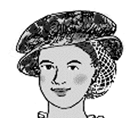
As a general rule, the younger someone was, the less likely they would be to have elaborate hairstyles or to cover their hair. Married women almost always covered their hair, and frequently turned to artificial means to create whatever hairstyles they chose. Men favored hats (and earlier, hoods), and were just as likely as women to expend all manner of effort to achieve a carefully constructed hairstyle or look.
Belts
Pockets are a relatively recent invention. Until their advent, well after the period in which we are working, everyone carried their necessities, if small, in pouches. (Or knapsacks or other large carryalls, or saddlebags and baggage trains if they were large.) In order to free the hands, pouches and other necessities were attached to a belt.
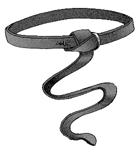 A belt is your carryall. In addition to your pouch, where
you might carry money, a small knife, a comb, tinder and flint, or other small items, you could
strap your tankard or goblet to your belt, carry a knife for eating or a sword for fighting, tie
favors or small tokens to show your attachment to a lady or membership in a group, carry your
household keys, prayerbook, pomander, fan...anything you would want to have at hand.
A belt is your carryall. In addition to your pouch, where
you might carry money, a small knife, a comb, tinder and flint, or other small items, you could
strap your tankard or goblet to your belt, carry a knife for eating or a sword for fighting, tie
favors or small tokens to show your attachment to a lady or membership in a group, carry your
household keys, prayerbook, pomander, fan...anything you would want to have at hand.
Practical leather belts were used by many people, including noble folk when they went hunting or crusading or any other activity where fashion might not be the most paramount concern. Lore has it that the very long knotted leather belts were originally worn by horsemen so that they would have an extra cinch or saddle leather if their horse's tack failed. Whether or not this is true, these belts were definitely quite common. A fancy belt might have tooled designs in the leather, or metal decorations along the length and at the tip, but the design was essentially the same.
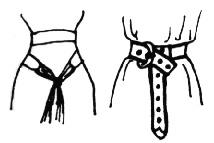 Other alternatives could be a wide woven belt, worn the same
way as the long leather belt. Pendant belts were quite long, and were wrapped twice or more around the
body and then knotted in the front. Just bear in mind that a non-leather belt will tend to fold
and wrinkle, so look for a fairly sturdy woven band.
Other alternatives could be a wide woven belt, worn the same
way as the long leather belt. Pendant belts were quite long, and were wrapped twice or more around the
body and then knotted in the front. Just bear in mind that a non-leather belt will tend to fold
and wrinkle, so look for a fairly sturdy woven band.
For some of the close-fitting styles of the 14th century, such as the cotehardie, the belt was worn very far down around the hips, making a very long leather belt quite ungainly. With these styles, a wide belt was worn, usually made of linked metal squares, or linked leather squares with metal or jewelled decorations.
With the wide, elaborate styles of the sixteenth century, sashes were sometimes used in place of belts, and were made of rich fabrics that matched the rest of the ensemble. To hold the weight of heavier objects, such as knives and swords, stiffer, heavy fabrics were used, or several sashes would be twisted together.
Pouches/Purses
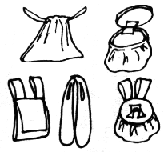 Once you have your belt, and you've hung it with mugs and knives and favors, you will still need a
pouch or purse to hold all the little sundries that you would put in mundane trouser pockets or
purses. Basically, all you need is some sort of bag that will attach in some way to your belt,
leaving your hands free, or a satchel/purse on a long strap that will be worn across your chest.
(NB: The pouch is far, far more common, but a satchel can be useful for carrying a large quantity of
things.)
Once you have your belt, and you've hung it with mugs and knives and favors, you will still need a
pouch or purse to hold all the little sundries that you would put in mundane trouser pockets or
purses. Basically, all you need is some sort of bag that will attach in some way to your belt,
leaving your hands free, or a satchel/purse on a long strap that will be worn across your chest.
(NB: The pouch is far, far more common, but a satchel can be useful for carrying a large quantity of
things.)
Drawstring pouches are the simplest; a little bag with a loop of cord or string running around the top opening, with the strings being long enough to also be used to tie to the belt. If you don't want to have to struggle with the strings every time you open the pouch, you can try a bag with a flap that is attached to one side of the opening and folds over to button or clasp closed. Put a loop on the back of the pouch to slip your belt through.
For a stiffer pouch, you can either use heavier leather, or run a stiffener (flexible boning or wire) through the rim of a flapped pouch, creating a wide opening which can be covered by a stiff leather flap or a covered balsa wood top. For the opposite extreme of a very floppy pouch, attach two tubes of fabric at one side of their mouths, to make a pouch that looks like two socks sewn together. It can be tucked through the belt so that a "sock" hangs on either side.
Shoes
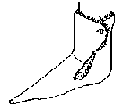
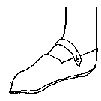 As appealing as it might seem to go barefoot, only some early Celtic sorts and some assorted
barbarians went barefoot on a regular basis. Most shoes were fairly simple, and nearly all the sewn
styles were made out of very soft leather or cloth, since the widespread use of a separate sole came
somewhat later in the renaissance period. To protect shoes outside, wooden clogs could be strapped
onto the feet.
As appealing as it might seem to go barefoot, only some early Celtic sorts and some assorted
barbarians went barefoot on a regular basis. Most shoes were fairly simple, and nearly all the sewn
styles were made out of very soft leather or cloth, since the widespread use of a separate sole came
somewhat later in the renaissance period. To protect shoes outside, wooden clogs could be strapped
onto the feet.
Most of the earlier shoes had their principal seam running up the top of the foot, with the heel piece sewn in behind, and were tied or wrapped around the ankle to stay closed. A later development was the lacing of the shoe over the vamp, or the use of a strap and buckle.
 Shoes with heavier soles do turn up later in the period, and also higher boots. The "cavalier" boots
with large, turned-down tops are current for the seventeenth century, which is after the focus of
these documents. However, since they look very nice, many people do decide to wear them with some of
of the later Elizabethan clothing. Strictly speaking, however, those articles of clothing were meant
to be worn with low shoes, showing off the lines of the leg.
Shoes with heavier soles do turn up later in the period, and also higher boots. The "cavalier" boots
with large, turned-down tops are current for the seventeenth century, which is after the focus of
these documents. However, since they look very nice, many people do decide to wear them with some of
of the later Elizabethan clothing. Strictly speaking, however, those articles of clothing were meant
to be worn with low shoes, showing off the lines of the leg.
Other Accessories
When serving a dinner or a feast, a host might provide spoons (the fork was a later development, and remained something of a novelty for a while), but everyone would have been expected to bring their own knives. While this made the knife a usual item to be worn on the belt, it did still limit knives for eating to ones that could concievably be used to do so. Throwing knives, large hunting knives, and other sizeable double-bladed knives were used for other purposes and would have been worn while engaging in those pursuits, but not for social occasions.Swords, on the other hand, were definitely a fashion accessory for the renaissance gentleman. The broadsword, so beloved by medieval fighters, was an enormous weapon that would have been worn in conjunction with other battle accoutrements, but not in the feast hall. The rapier, because of its relatively small size and light weight, was worn by most gentlemen of means towards the later part of our period. The hilts were often quite elaborate, and also used as an elegant place to rest one's off hand when in a casual stance.
Jewelry varied widely, even within a particular period. As a general rule, though, it became more ornate as time passed. Take a look at the portraits in some of the costume resources for a better idea. Women did have pierced ears quite early on, as did many men. Watches did not really exist, and were not worn.
Besides the decorative capes worn by 16th century men, cloaks were the predominant outer garment for inclement weather for nearly every century. Both full-circle and half-circle cloaks were common among those who could afford them; those who could not often pinned a blanket around their shoulders for much the same effect.
As with the pages on men's and women's garb, these notes and images are provided for a sweeping overview. Take a look at some of the other resources in these pages to get a fuller idea of what you want. For some jumping-off points, consult the Costume Links page.